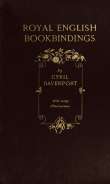You are here
قراءة كتاب Royal English Bookbindings
تنويه: تعرض هنا نبذة من اول ١٠ صفحات فقط من الكتاب الالكتروني، لقراءة الكتاب كاملا اضغط على الزر “اشتر الآن"
align="right">61
⁂The Coloured Plates are printed by Edmund Evans.
ROYAL ENGLISH BOOKBINDINGS
PROLOGUE
It is curious that twice in English history the royal libraries have been given to the nation. The ancient royal collection, containing manuscripts from the reign of Richard III., was added to by each sovereign in turn; but it seems to have been brought into notice and taken special care of by Prince Henry, the eldest son of James I. Out of his own private income, this Prince added largely to the old collection, and purchased the important libraries of Lord Lumley, of a Welshman named Maurice, and that of Isaac Casaubon. On his death the library became the property of James I., and after some other changes, both the old library and that of Prince Henry were deposited at Ashburnham House, where in 1731 there was a fire which damaged some of it. It was then removed to the old Dormitory at Westminster, and in 1757 it was presented by George II. to the nation, and was handed over to the Trustees of the Sloane and Cottonian Libraries, and placed in Montagu House, then newly purchased as a National Museum. There were at this time in the old royal library about 15,000 volumes altogether, and very many of them were still in their ancient and beautiful bindings.
George III., finding on his accession to the throne that there was no royal library, very energetically set to work to form a new collection. He chose his agents very carefully, and appointed Sir Frederick Barnard to be his librarian. Sir Frederick travelled widely in search of books, and, acting partly under the advice of Dr. Samuel Johnson, eventually brought together perhaps the finest collection of books ever made by one man. On the king’s death the library contained upwards of 65,000 volumes, besides more than 19,000 separate tracts and some manuscripts.
Generally speaking, the bindings in the “King’s Library”—the name by which George III.’s collection is now known in the British Museum—are modern; but among them are a considerable number of old bindings in good condition, and it is possible that those which were rebound were mostly in a bad state. Unfortunately the crowned monogram of George III. is generally impressed in a prominent place, even on such old bindings as have been otherwise preserved intact; and although valuable as a record it is often a great disfigurement. There is little doubt that George III.’s intention was to create a new royal library to remain in the possession of the kings themselves, but there seems to have been some idea that it would eventually become national property, as Dr. Frederick Wendeborn, a German preacher, well known at Court, wrote: “The King’s Private Library ... can boast very valuable and magnificent books, which, as it is said, will at one time or another be joined to those of the British Museum.” This prediction was fulfilled in 1823, when George IV. presented it to the nation, and the fine room now known as the King’s Library in the British Museum was built for its reception, the removal being completed in 1828.
William IV. does not seem to have been altogether pleased that the royal libraries should have been twice given away, as he added a codicil to his will in 1833, bequeathing to the Crown “all his additions to the libraries in the several royal palaces,” with an autograph confirmation dated from Brighton, November 30, 1834, signed and sealed by himself, declaring “that all the books, drawings, and plans collected in all the palaces shall for ever continue heirlooms to the Crown, and on no pretence whatever to be alienated from the Crown.”
The royal library at Windsor now contains the greatest number of royal bindings now existing in any one collection, except those at the British Museum, but it possesses very few that belonged to Tudor sovereigns. From the time of James I. it has a very fine collection.
Where I have not specifically mentioned otherwise, the books described in the following pages are in the British Museum. They should be to the English people especially interesting, for not only are they national property, but any of them can be seen with little trouble, and



